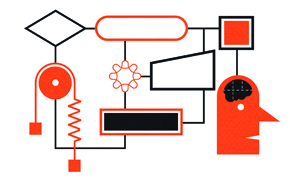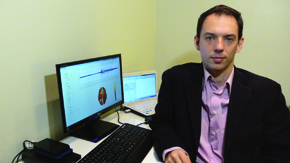 Daniel BuenoAdenauer Casali, 35, from the state of Rio Grande do Sul, has a unique academic career. He has a degree in physics from the Federal University of Santa Maria and a master’s degree supervised by Professor Elcio Abdalla that he earned in 2003 from the University of São Paulo in string theory models in the area of cosmology. He was also approved for a doctoral project in the same line of research. “In that time frame I had already published a few articles, but I was a bit disappointed with the direction in which theoretical physics was headed in Brazil, as it was dominated by the string theory paradigm,” says Adenauer. “This is a very abstract area of mathematics and no one imagined the possibility of testing the theory experimentally.” Slowly but surely, his motivation to continue research in the area faded away and he just gave up on physics. “I returned to Rio Grande do Sul and decided to learn something about the financial market,” he says. He spent a year and a half studying the derivatives market. “But I was still interested in science and was implementing projects in the area of quantum information, and then the opportunity arose to go to Italy.” At the time, his wife, whom he met in graduate school, had gone to Milan for a “sandwich” doctorate. He took advantage of the opportunity and submitted a proposal for a one-month project to a quantum information school in Trieste.
Daniel BuenoAdenauer Casali, 35, from the state of Rio Grande do Sul, has a unique academic career. He has a degree in physics from the Federal University of Santa Maria and a master’s degree supervised by Professor Elcio Abdalla that he earned in 2003 from the University of São Paulo in string theory models in the area of cosmology. He was also approved for a doctoral project in the same line of research. “In that time frame I had already published a few articles, but I was a bit disappointed with the direction in which theoretical physics was headed in Brazil, as it was dominated by the string theory paradigm,” says Adenauer. “This is a very abstract area of mathematics and no one imagined the possibility of testing the theory experimentally.” Slowly but surely, his motivation to continue research in the area faded away and he just gave up on physics. “I returned to Rio Grande do Sul and decided to learn something about the financial market,” he says. He spent a year and a half studying the derivatives market. “But I was still interested in science and was implementing projects in the area of quantum information, and then the opportunity arose to go to Italy.” At the time, his wife, whom he met in graduate school, had gone to Milan for a “sandwich” doctorate. He took advantage of the opportunity and submitted a proposal for a one-month project to a quantum information school in Trieste.
Upon completing his studies he met Professor Marcello Massimini from the University of Milan, who was setting up a transcranial magnetic stimulation and EEG laboratory; Massimini needed someone to program the signal processing and analysis tools. “Since I learned how to program at the university, I accepted the proposal,” he says. For about a year he conducted programs for the laboratory, and in 2007 he was hired as a researcher. “I realized the great potential of the technique and I decided to study physiology, and in early 2009 I submitted a scientific proposal for a doctorate in the area.”

Adenauer Casali Adenauer Casali: Distinct universesAdenauer Casali
In his PhD, which he defended in January 2012 at the University of Milan School of Medicine, Casali worked with Massimini and developed a new method for measuring the level of consciousness in people with brain damage. “This is an objective measurement used as a scale for the level of consciousness,” he says.
Named PCI (perturbational complexity index), the method made the cover of the August 14 issue of the journal Science Translational Medicine. “The publication caught the eye of European and American groups for using the technique in clinical research, not only to measure the level of consciousness, but also to assist in the diagnosis and prognosis of other conditions in which areas of the brain may be altered, such as schizophrenia and depression,” he notes. When he returned to Brazil in 2012 he continued to work with foreign groups, such as Milan, the University of Liège in Belgium and the University of Wisconsin in the United States because the technique is not yet used in clinical research in Brazil. Since July this year, after being invited by Professor Maria Claudia Irigoyen to work on cardiac signal processing, he has been doing graduate work at the Heart Institute (InCor).
For Casali, it was the flexibility that he acquired through his training in the exact sciences that enabled him to transit through such different universes. “I learned how to deal with data in an organized manner, which is common to many areas of knowledge.”
Republish